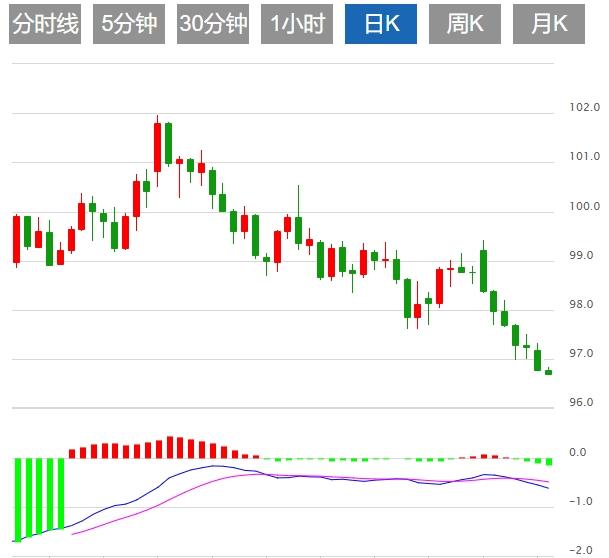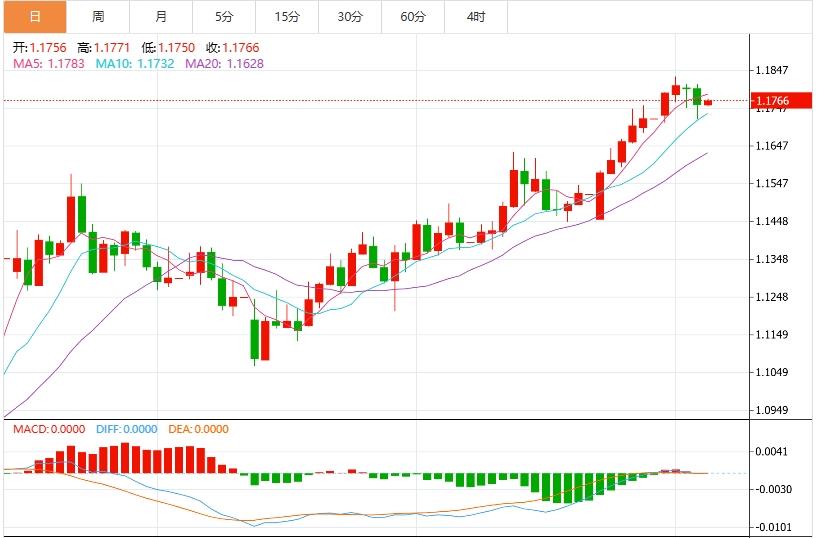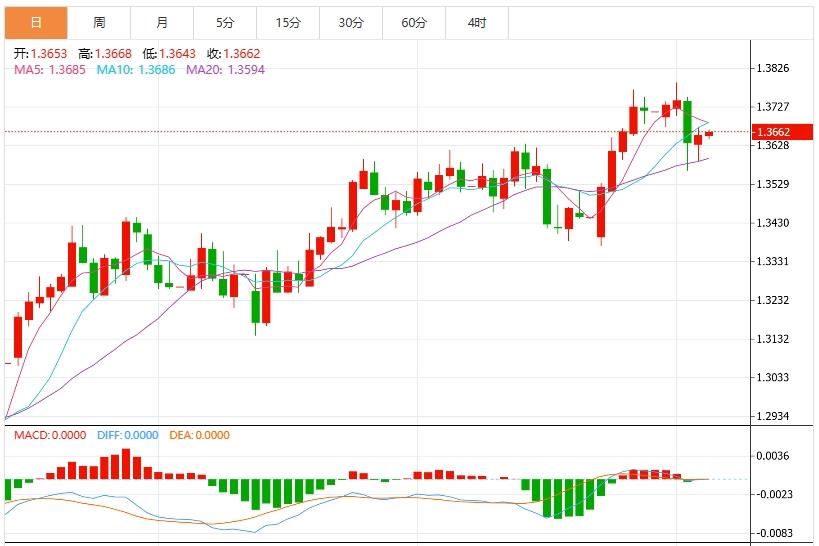Wonderful Introduction:
Youth is the nectar made of the blood of will and the sweat of hard work - the fragrance over time; youth is the rainbow woven with endless hope and immortal yearning - gorgeous and brilliant; youth is a wall built with eternal persistence and tenacity - as solid as a soup.
Hello everyone, today Avatrade Aihua Foreign Exchange will bring you "[Aihua Ava Foreign Exchange Decision Analysis]: Who will occupy the www.avaforexcn.commanding heights in the US dollar index long and short confrontation? Focus on the minutes of the Federal Reserve meeting." Hope it will be helpful to you! The original content is as follows:
On the Asian session on Monday, the U.S. dollar index hovered below 97, and the U.S. dollar fell against other major currencies last Friday after the iconic tax cut bill promoted by President Trump was finally passed and countries face pressure to reach a trade deal with the United States. It is approaching the July 9 deadline for tariff suspension, and the market is in a strong wait-and-see mood; the US Treasury Secretary hinted on Sunday that the deadline for tariff restart was changed to August 1, which also slightly weakened market concerns. In addition, minutes of the Federal Reserve meeting will be released this week, and investors need to pay attention to it.
Analysis of major currency trends
U.S. dollar: The US dollar index hovers around 96.95. Recently, the trend of the US dollar index has been driven by multiple fundamental factors. First, Trump's tariff remarks continue to ferment, and market concerns about the global trade prospects are intensifying. This week the Federal Reserve will release minutes of its last FOMC meeting, and the market is highly concerned about whether it sends out signals that it may cut interest rates in the future. Analysts pointed out that if the minutes are biased, it means that policymakers are cautious about the economic outlook, and the dollar may face pressure to pull back; on the contrary, if the need to maintain high interest rates is emphasized, it is expected to boost the dollar's strength. Although the United States has limited macro data next week, the non-farm employment data in June was strong and the unemployment rate fell, providing some support for the US dollar. Technically, the US dollar index is below the 20-day moving average, which is also the middle Bollinger band, indicating that the upward action energy is still weak. Unless the bulls can achieve a clean breakout around 97.00–97.20, a wider bearish trend is likely to continue. Momentum indicators also reflect cautious attitudes. Relative Strength Index (RSI) hovered above 34, still lookingbut showed signs of early stability. Meanwhile, the rate of change (ROC) remains negative, indicating that the selling pressure remains, although there is no acceleration.



1. US dollar: policy minutes and tariff time limit will dominate
This week, the Federal Reserve will release the minutes of the last FOMC meeting, and the market is paying close attention to whether it sends out a signal of possible interest rate cuts in the future. Analysts pointed out that if the minutes are biased, it means that policymakers are cautious about the economic outlook, and the dollar may face pressure to pull back; on the contrary, if the need to maintain high interest rates is emphasized, it is expected to boost the dollar's strength. Although the United States has limited macro data next week, the non-farm employment data in June was strong and the unemployment rate fell, providing some support for the US dollar. In addition, July 9th sets a deadline for the Trump administration’s tariff exemption period. Analysts believeIf no agreement is reached with major trading partners by then, the market expects to quickly reflect the rising risk aversion sentiment, and the US dollar may benefit, but it may also cause severe fluctuations in the foreign exchange market.
2. British Pound: Differences in economic data and policy have intensified fluctuations
The UK will release May GDP data and manufacturing output on Friday, becoming a key variable affecting the trend of the British Pound. Analysts believe that if the data shows that economic activity will rebound, it may support the pound; otherwise, it will intensify concerns about the weakening of the UK economy. At the same time, there were obvious differences within the Bank of England. Monetary Policy www.avaforexcn.committee Member Alan Taylor pointed out that there are cracks in the labor market and advocated that as many as five interest rate cuts will be implemented in 2025, which is significantly deviating from current market expectations. Analysts believe that such dovish remarks may drag down the performance of the pound, and the market will also pay close attention to whether more officials follow up to form a consensus on the shift in policy paths.
3. Yen: Policy expectations and external risks are intertwined
Although the Bank of Japan has not released major data, its recent statements have triggered the market to re-evaluate the policy trend. President Kazuo Ueda said that the basic inflation was slightly lower than 2%, while deliberation www.avaforexcn.committee member Takada pointed out directly that the current interest rate hikes are only suspended and policies may still be tightened in the future. Such remarks are interpreted by the market as implicit hawkish tendencies, which helps the yen to maintain its firmness. However, uncertainty in Japan-US trade negotiations remains the main risk factor. Analysts believe that if an agreement on tariffs cannot be reached before July 9, the yen may be pushed up due to the rising risk aversion sentiment, and may also bear the pressure of uncertainty brought about by policy games.
4. Euro: Slowing inflation and confidence index will guide expectations
In the euro zone, Germany's HICP rose only 2% year-on-year in early June, lower than the expected 2.2%, indicating that inflation momentum has weakened and weakened the basis for the European Central Bank to tighten its policies. The market will closely monitor the released Sentix Investor Confidence Index, and the performance of this indicator will become an important reference for judging the economic sentiment of the euro zone. Despite this, European Central Bank President Lagarde stressed that he would vigorously deal with the phenomenon of continuing to deviate from inflation targets, with a slightly hawkish tone, providing short-term support for the euro. Analysts believe that if the Sentix index improves, it may provide an opportunity for the euro to repair it, otherwise it will continue to have a weak trend.
5. Australian dollar: Interest rate resolution becomes the focus
The Australian Federal Reserve (RBA) will hold an interest rate meeting. The market has currently included the probability of a rate cut of 84.6%. It is expected that the expectation of three interest rate cuts this year will continue to ferment. Analysts believe that if the statement further confirms the easing rhythm, the Australian dollar may be under pressure; but if the tone is cautious and interest rate cuts are suspended, it may repair the short-term fatigue of the Australian dollar. Although the manufacturing PMI was slightly lower in June, it was still above the boom-bust line (50.6), indicating that the manufacturing industry has not yet fallen into recession. However, analysts believe that the sharp shrinkage of the trade surplus in May implies that external demand has weakened and we need to be vigilant about putting pressure on the Australian dollar.
Institutional View
1. FAC: The end of the year may be a critical moment for the ECBThe euro is expected to rise to 1.20-1.30
Facebook believes that the end of the year may be a critical moment for the ECB, as inflation will be significantly below target levels and may lower inflation expectations, which will require the ECB to take more easing measures. Concerns also emerged this week, with the euro hitting a new high against the dollar this week due to the rapid appreciation of the euro. A survey conducted by the bank with its clients showed that the vast majority of people expect the euro to continue to appreciate by the end of the year, with appreciation ranging from 1.20 to 1.30.
2. UBS: Targeted tariffs may support the US dollar
UBS Global Wealth Management analyst said in a report that the most favorable result for the US dollar in the short term will be the implementation of targeted tariffs by the United States. After a 90-day suspension, the deadline for reimbursing higher reciprocity tariffs on July 9 is approaching. Analysts say the U.S. could impose tariffs on countries that have not made significant progress in trade agreements, while extending tariff moratoriums on those countries that have made progress. Targeting individual countries in trade wars often strengthens the dollar, while widespread tariffs usually weaken the dollar.
3. Market analysis: The yen may be boosted by an increase in interest rate hike bets
Mitsubishi UFE analyst Derek Halpenny said in a report that if the market increases bets on further interest rate hikes this year, the yen may strengthen in the www.avaforexcn.coming months. Data shows that the market only priced the expectation of a 3 basis point interest rate hike in September. He said this looked too low. If the U.S. and Japan reach a less destructive trade deal before the reciprocal tariff moratorium ends on July 9, it will increase the likelihood of the Bank of Japan's interest rate hikes. After negotiations, wages rose in Japan, with data on Friday showing a surge in household spending in May, which should also encourage further rate hikes.
The above content is all about "[Ava Foreign Exchange Decision Analysis]: Who will occupy the www.avaforexcn.commanding heights in the US dollar index long and short confrontation? Focus on the minutes of the Federal Reserve meeting" and is carefully www.avaforexcn.compiled and edited by the Avatrade Foreign Exchange editor. I hope it will be helpful to your trading! Thanks for the support!
Due to the author's limited ability and time constraints, some content in the article still needs to be discussed and studied in depth. Therefore, in the future, the author will conduct extended research and discussion on the following issues:















